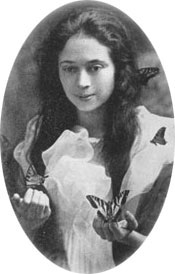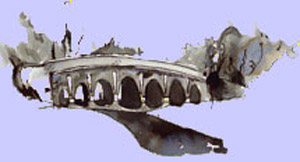|
|
|
| Feature Articles: Famous Napsbury Residents |
| A series of articles on famous Napsbury Hospital Residents |
| Opal Whiteley |

The story of Opal Whiteley is the
last in our series on ‘Famous Patients’.
Opal Irene Whiteley was born on December 11, 1897, the eldest of five
daughters of a logging family who followed work to Cottage Grove, Western
Oregon where she was brought up. Her grandmother remembered her as a queer
girl, always asking questions and
chattering, when she wasn’t
reading or writing, and prone to bouts of inattention and absentmindedness.
Nor were her faults corrected by frequent ‘switchings’: a favoured
punishment in those harsh times.
Her childhood spent wandering the woods fuelled a very scientific interest
in nature.
She made a huge collection of plants and reputedly had a way with animals
who would often come to her hand to be studied.
Opal was admitted to the University of Oregon in 1916 where she was noted
for her voracious reading, her fey habit of talking and singing to animals
and her ‘New Age’ appearance. With her flowing skirts and long
plaits flying out behind her as she ran, she was a prototype for the hippies
of the 60s who believed, as did Opal, that we should all encounter and
love nature and one another.
Opal’s mother died from cancer in 1917, her maternal grandmother
died on the next day and it is thought that she never recovered from this
double blow. After that she seldom saw her family and abandoned the church
activities of her youth. She attempted to get into films, travelling to
Los Angeles with a set of professional photographs that she touted round
the studios without success. She turned to teaching the children of wealthy
Californians about nature and raised an enormous amount of money from
private subscription.
This she paid to a printer for the publication
of her book ‘The Fairyland Around Us’. The book was to have
fulfilled a long held ambition but Opal made so many changes to her manuscript
during printing that the printers overspent. Tragically, when she was
unable to pay, they destroyed the plates and she was left with printed
sheets, which she attempted to paste together into a book.
Some say that this was when her mental condition deteriorated in earnest.
In pursuit of a publisher for her book she travelled to Boston where she
found Ellery Sedgwick, editor of The Atlantic Monthly. He was enchanted
with her, though not with ‘Fairyland’, and lodged her with his
mother-in-law while she pieced together the diary she claimed to have
written as a child and which had been ‘torn up by a jealous sister’.
The diary, The Story of Opal - Journal of An Understanding Heart was an
immediate success when it was serialised in The Atlantic Monthly. These
touching stories of an Oregon childhood portrayed Opal as at once innocent
and knowing. In them she skipped through the woods in the company of animals,
rejoicing in the wonders of God’s nature while nursing the effects
of yet another walloping from the unsympathetic adults who surrounded
her.
“The back part of me feels a bit sore, but I am happy, listening
to the
twilight music of God’s good world. I’m real glad I’m alive.”1
It sounds self conscious and quaint to the modern ear but her adoring
audience was eager to drink in Opal’s innocence after the horrors
of WWI. Unfortunately, more startling revelations followed when her diary
was published as a book. She was in fact not Opal Whiteley, but the kidnapped
daughter of a French prince - she had been substituted for the real Opal
Whiteley, who had drowned. Her “Angel Father” was Henri d’Orleans,
of the deposed royal family, who had died in India in 1901.
This proved too much to swallow. Sceptical articles and even a literary
parody appeared in reputable magazines. Her family back in Oregon were
‘researched’ so thoroughly that they left town and changed their
names. Her book disappeared from the bookshops and Opal was left alone
to elaborate her fantasies of royal connections.
Despite her catastrophic fall from grace she remained able to charm the
wealthy and, nothing dismayed, made new friends who paid for a trip to
Europe where she spent some time with the mother of Henri d’Orleans
in France. From there to India in her royal father’s footsteps to
live as a royal guest of the Maharana of Udaipur.
Then silence… No more was heard of her from the early 1930s until
1948 when she surfaced again, living in London in a squalid Hampstead
bed-sitter surrounded by 10,000 - 15,000 books. She was declared a ward
of the state and committed to Napsbury Hospital.
Carlisle Moore, professor emeritus of English at the University of Oregon
corresponded with her and visited her a number of times when on sabbatical
in the 1960s. He disputed her claim that she was confined against her
will stating that “it was obvious that she couldn’t take care
of herself.” He was “certain she was not in possession of the
real facts of her life” and said that she talked about her upbringing
in France and Italy even though “she knew she was not believed, and
yet she insisted on it.”
Her insistence paid off in the end for, sometime in the 1960s, staff at
Napsbury began calling her Francoise d’Orleans and, it is said, even
changed her name in hospital records.
2In 1983 she was rediscovered by American writer Benjamin Hoff who published
her diary along with an extensive foreword under the title “The Singing
Creek Where The Willows Grow”. The book was finally published in
Opal Whiteley’s 90th year. Her psychiatrist revealed that “she
knew that it was ‘her’ book at last” though her eyesight
was so poor that she could not see the photographs and had to feel for
the embossed title on the hard cover.
She died in 1992 aged 94. Her gravestone in Highgate Cemetery bears both
names... Francoise d’Orleans and Opal Irene Whiteley. I leave the
reader to decide which name was real and which imagined.
3Maria Aguado
1 The Story of Opal - Journal of An Understanding Heart, Opal Whiteley
(1920)
2 Beryl Carrington, Herts Advertiser Friday November 20th 1987
3 Thanks to Steve McQuiddy for permission to use information from his
websiteand pictures of Opal aged19 and in her 60s , do read his very informative
article at http://www.intangible.org/Features/Opal/OpalHome.html |
|
|




